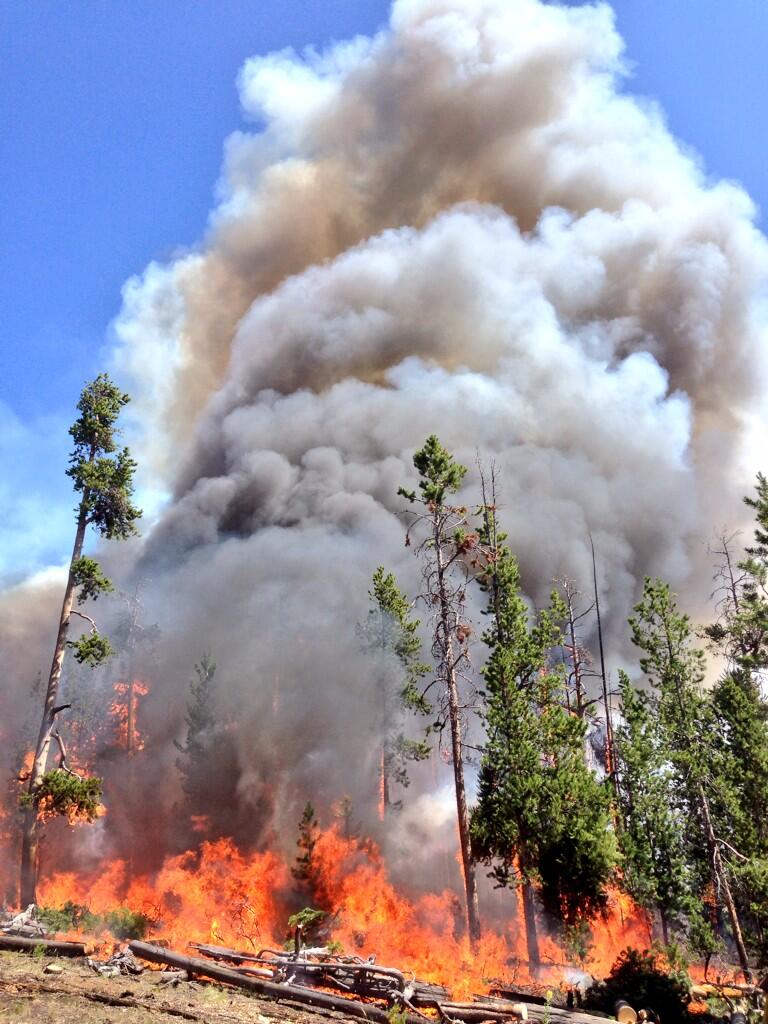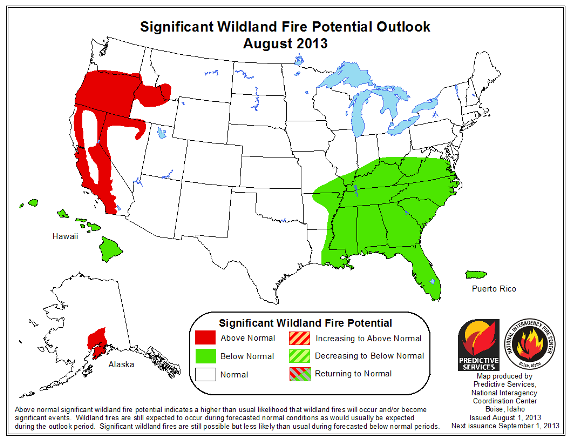The Pike Hotshots took these photos at the Lodgepole Fire near Challis, Idaho; they are used with permission here. Click the images to see larger versions. The crew was recently released from the fire and is headed home for some days off.
Author: Bill Gabbert
Rolling Stone covers wildfire
We’re not sure if it made the cover of Rolling Stone, but the August 15, 2013 issue has an interesting article titled “The Great Burning — How Wildfires Are Threatening the West: Terrifying blazes are the new normal in the West, where a mix of climate change and Tea Party politics has put an entire region at risk.”
The piece written by free-lancer Osha Gray Davidson of Phoenix, uses the tragic Yarnell Hill Fire as an anchor, but primarily covers the current state of wildfire management and suppression. He mentions several examples of how politicians are using that fire and the deaths of 19 members of the Granite Mountain Hotshots as leverage to criticize existing federal forest management and to introduce legislation to increase logging on national forests, in spite of the fact that the Yarnell Hill Fire was not on federal land and there were virtually no trees in the area.
Mr. Davidson ends the article by writing about the Granite Mountain Hotshots:
“Granite Mountain was the only hotshot crew in the nation that was attached to a city fire department. [Rick Heron, part of another Arizona crew that worked on the Yarnell Hill fire], says that may be why the Granite Mountain Hotshots had a unique reputation. “They were the most family-oriented crew I’ve ever met,” he says. Perhaps, Heron speculates, those very ties caused them to continue battling the blaze when bad weather was moving in. “If you’re talking about houses that belong to your neighbors or cousins or to your Uncle Jimmy,” he says, “it makes it harder to leave.”
If that is what happened, then the saddest irony of the tragedy on Yarnell Hill may be that the Granite Mountain Hotshots lived their lives and met their deaths out of a sense of communal responsibility – the very opposite of the culture that has gotten us into such a fatal situation in the first place. It seems reasonable to wonder: If America behaved more like the Granite Mountain crew, perhaps our fire problem wouldn’t be so intractable.”
****
If you leave a comment below, please avoid partisan politics.
Wildfire smoke causing “hazardous” air quality in southwest Oregon

Smoke from wildfires in southwest Oregon is being trapped by unstable air, causing the air quality index in some areas to reach “very unhealthy” and even “hazardous” levels, according to the Oregon Department of Environmental Quality. One of our loyal readers in the Rogue Valley wrote to tell us that the smoke has been dense enough to set off smoke alarms inside some buildings, and said:
Some folks are heading north to Eugene or Portland to escape it. I just walked to another building on our corporate campus and back, and my hair smells like smoke. Some fools are still out running in this, but others are starting to wear masks.
Some of the cities affected are Grants Pass, Medford, and Ashland. Much of the smoke is coming from the 28,000-acre Douglas Complex which began after 54 fires were ignited by lightning west of Medford on lands protected by the Douglas Forest Protective Association.
An air quality index (AQI) of less than 50 is considered “Good”. The next level up is “Moderate”, eventually working up to the highest level which is “Hazardous” beginning at an AQI of 300. We checked the levels at Medford at 3:20 p.m. Thursday and it was 229, “Very Unhealthy”. We understand that the smoke disperses more during the day, but settles into the low-lying areas at night, making conditions worse.

You can find the very handy map above at the web site of the Oregon Department of Environmental Quality. The dots indicate the location of real-time air quality monitoring stations; the darker dots have the worst air quality. When you’re there, click on them to see the details.
About masks for protection from smoke — disposable dust masks or bandannas over your nose will do NOTHING to protect you from the EXTREMELY TINY smoke particles that are so small that if you dropped one from near the ceiling in a room with calm air, it would take eight hours for the particle to fall to the floor. You need a particular kind of respirator if you really want protection. Here is an excerpt from the Mail Tribune on the subject:
People who must be outside should avoid physical exertion and wear a particulate respirator if possible, [Jackson Baures, Jackson County public health division manager] said. Masks that help filter out the tiny particulates have the acronym “NIOSH” — National Institute for Occupational Safety and Health — printed on it, along with “N95” or “P100,” he said. Wearers should make sure the respirator fits properly and does not leak around the sides. Dust masks that are not NIOSH-certified may not protect wearers from fine particulate matter, even if they are worn properly, he said.
A firefighter says she’s hanging up her boots; really, this time
Mary Emerick has written an interesting article about getting out of firefighting after 26 years. She says she really means it this time.
Below is a short excerpt — you can read the rest of article here. You may have to answer a couple of stupid questions there to see the whole piece.
…All firefighters have stories of lucky breaks and last-minute escapes — when certain tragedy was averted only by a wind shift, quick thinking or plain chance. There was a wonderful monotony in the work itself, seeing just how far I could push my body past exhaustion. I worked 48-hour shifts, coughing into a grimy bandanna pulled tight across mouth and nose, hauling 40-pound containers of drinking water up a mountain, watching the ceaseless motion of moving vegetation out of a slim line that might stop the fire — or not.
There were things I missed by fighting fire: love, marriage, kids — even though I wasn’t sure I wanted that kind of life. I missed out on the vacations that normal people enjoy — swimming in lakes, lying in hammocks.
Wildfire potential, August through November, 2013
Today the Predictive Services section at the National Interagency Fire Center issued their Wildland Fire Potential Outlook for August through November, 2013. Here is their prediction for August:
Significant fire potential remains above normal for a large portion of the Northwest and the California mountains as fuels remain much drier than normal. South central Alaska will have higher significant fire potential in early August. The East will remain wet through August.
One firefighter killed, another injured in Oregon
One firefighter has died and another was injured by a falling snag in the Deschutes National Forest near Sisters, Oregon on Thursday, August 1. The incident occurred on a new lightning-caused fire, named 398, north of Highway 242 near Dugout Lake. The two firefighters were contract personnel working as a tree falling team employed by R&K Water Services out of Bonney Lake, Washington. The names have not been released. The Deschutes County Sheriff’s Department is in charge of the accident..
The incident was reported at 9:13 a.m. Thursday, according to Jean Nelson-Dean, a spokesperson for the Deschutes National Forest.
A rappel crew responded in a helicopter to the accident and called for an ambulance. One of the firefighters died at the scene. The other was taken to St. Charles Medical Center in Bend. A water-dropping helicopter wet down the area to make it safer for other firefighters to assist with the incident.
An early morning lightning storm started dozens of wildfires in the Cascade Range of Oregon on Thursday.
Our sincere condolences go out to the families and coworkers of these firefighters.






